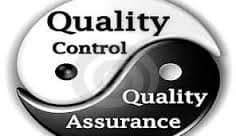Asset owners are tasked with maximizing their return on investment (ROI). This can pose challenges when deciding where to utilize their limited resources, independent of whether the project is new construction or rehabilitation of an existing asset. While most can agree that the success of a project can be determined by maximizing longevity or “quality per dollar spent,” there is much discussion on how and where to spend these dollars, especially when something as intangible as “quality” enters the discussion. This may lead to the debate of the need for both quality assurance (QA) and quality control (QC) personnel on a single project. This brief article explores the similarities and differences between QA and QC, the personnel, and the roles each play on a given project.
The terms quality assurance and quality control are often used synonymously and may be thought to be interchangeable, but there are distinct differences and both are critical to the success of a project. That is, the two work together as an integral part of a quality management system (QMS). It is important that all stakeholders have the same understanding of these terms and understand the roles and responsibilities of both to create an effective QMS.
A properly implemented QMS can contribute to the longevity of any asset, thus maximizing the ROI, as well as helping to ensure relevant data collection to assist in decision making in the future. Conversely, lack of a QMS can cause project delays, reduce service life, and create the need for expensive repairs in the future.
What’s the difference Between QA and QC?
Quality assurance and quality control personnel and their responsibilities overlap, which lends itself to confusion that could affect the total quality system. This is why it is important for decision makers, managers, and those in the field to understand the differences between the two and, more importantly, how they work together.
Let’s start by defining Quality. According to ISO 9000, “Quality is the degree to which a set of inherent, existing characteristics of an object fulfils requirements.” Simply stated, the final product meet the customer’s specified requirements. ISO 9000 notes “Quality Management” can include establishing quality policies and quality objectives and processes to achieve these quality objectives through quality planning, quality assurance, quality control, and quality improvement.
Boil this down and we end up with the understanding that a QMS is a set of interrelated or interacting elements that establish policies, objectives, and processes to achieve those objectives. Objectives are stated in the project specification by establishing acceptance criteria. For example, “All surfaces to be painted shall be abrasive blast cleaned to SSPC-SP 10.” The testing process by which we determine if the product is accepable may be referenced in the standard, or may be called out in the specification if there is more than one test procedure. For example, “Surface profile shall be between 1.5 – 3.0 mils. Measure surface profile in accordance with ASTM D4417 – Method B.”
 So who is responsible for determing whether the work is acceptable? The answer is both QC and QA personnel. According to Merriam-Webster, control is defined as “to check, test, or verify by evidence or experiments” and assurance is defined as “confidence of mind or manner.”
So who is responsible for determing whether the work is acceptable? The answer is both QC and QA personnel. According to Merriam-Webster, control is defined as “to check, test, or verify by evidence or experiments” and assurance is defined as “confidence of mind or manner.”
This is the difference:
- QC personnel perform the testing and compare the results to the specification requirements. They are contractually responsible for controlling the quality of the work performed. But unless they have authority, as well as first-hand knowledge of the specification requirements and testing procedures, they cannot contol quality.
- QA personnel check the test procedures used by quality conrol personnel and verify the accuracy of the data in order to provide confidence in the results. They are ultimately responsible for assuring the quality of the work performed. But unless they have first-hand knowledge of the specification requirements and testing procedures they cannot assure quality. They may or may not have authority depending on whether they are the owner or a thrird party.
From this explanation, we can better understand that the QC role is to conduct tests and verify by evidence that the product meets the specified requirements. The QA role is to verify the QC tests are conducted in accordance with the appropriate standard. This procedure-based approach is critical to ensure the tests results are reliable and meaningful. We cannot expect reliable or consistent results without proper controls and consistent testing. This is achieved by performing the tests using accepted methods and procedures.
Isn’t QC analogous to the “fox watching the hen house?”
 A fair question, but controlling the quality of the work as it is being performed is a contractual obligation. For example, a simple requirement that may appear in a coating specification is, “The primer shall be applied to a dry film thickness of 2-4 mils, as measured from the peaks of the surface profile.” The only way that a contractor can prove to the owner that the primer has been applied to the required thickness is to measure it using a calibrated coating thickness gage that is verified for accuracy prior to use and adjusted to remove any effect of the base metal. The measurements are documented and results compared to the governing specification. The results of this quality inspection either demonstrate conformance or indicate that rework is required. In this case, quality is being controlled by the party that has the greatest ability to influence it – the party executing the work.
A fair question, but controlling the quality of the work as it is being performed is a contractual obligation. For example, a simple requirement that may appear in a coating specification is, “The primer shall be applied to a dry film thickness of 2-4 mils, as measured from the peaks of the surface profile.” The only way that a contractor can prove to the owner that the primer has been applied to the required thickness is to measure it using a calibrated coating thickness gage that is verified for accuracy prior to use and adjusted to remove any effect of the base metal. The measurements are documented and results compared to the governing specification. The results of this quality inspection either demonstrate conformance or indicate that rework is required. In this case, quality is being controlled by the party that has the greatest ability to influence it – the party executing the work.
Putting it all together
Although QA and QC roles are different, the purpose in the end is the same. Quality is only achieved when the test results meet the acceptance criteria established by the specification AND are reliable because the tests procedures used were conducted in accordance with the standard. With roles and responsibilities of QA and QC personnel clearly understood, there will be less opportunity for non-conformities, resulting in lower costs and on-time delivery. And at the end the owner will have a quality product that maximizes the asset’s service life at reduced overall costs, while the contractor preserves their reputation for providing quality work that helps ensure a continuous revenue stream.



The terms QA and QC are so much used interchangeably; so much so, that before reading this article I was using a wrong title for the job that I have been doing for so many years. Thank you so much for sharing this article.
Pooyan,
We appreciate your support for KTA University. We’re glad you were able to gain some knowledge from our article, and hope you’ll continue reading our content. Check back to KTA University every Friday at 9am for a new article!
Thanks again for your support,
Jason Weslager
KTA Marketing Department
Thanks Jason, appreciate your kind efforts.
Cheers, pooayn.
Pooyan,
Appreciate it. Glad you enjoy our content. Be sure to check back every Friday at 9am for new articles!
Thanks for your support,
Jason
Lovely and well described about QA and QC field
Loved it.